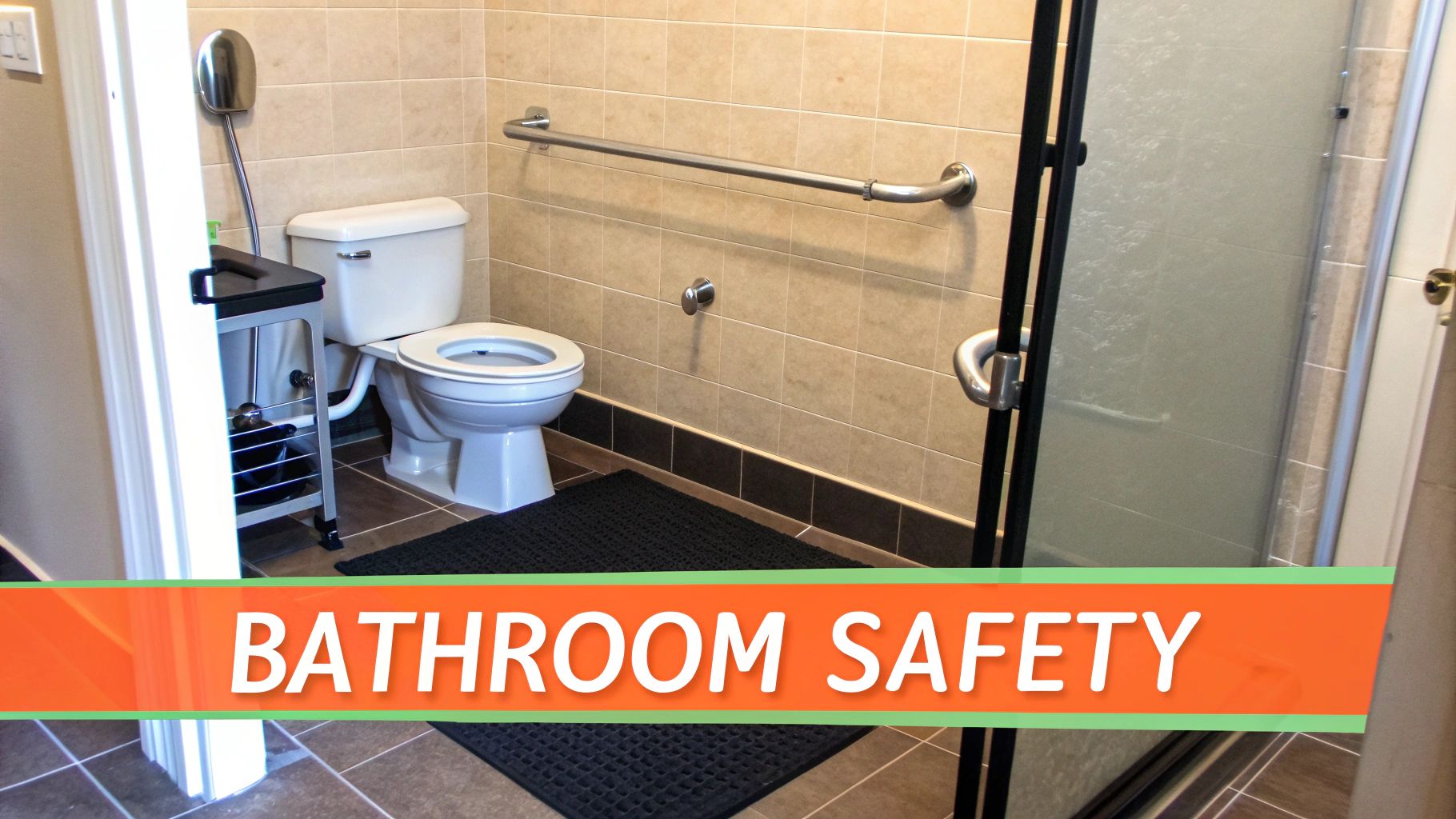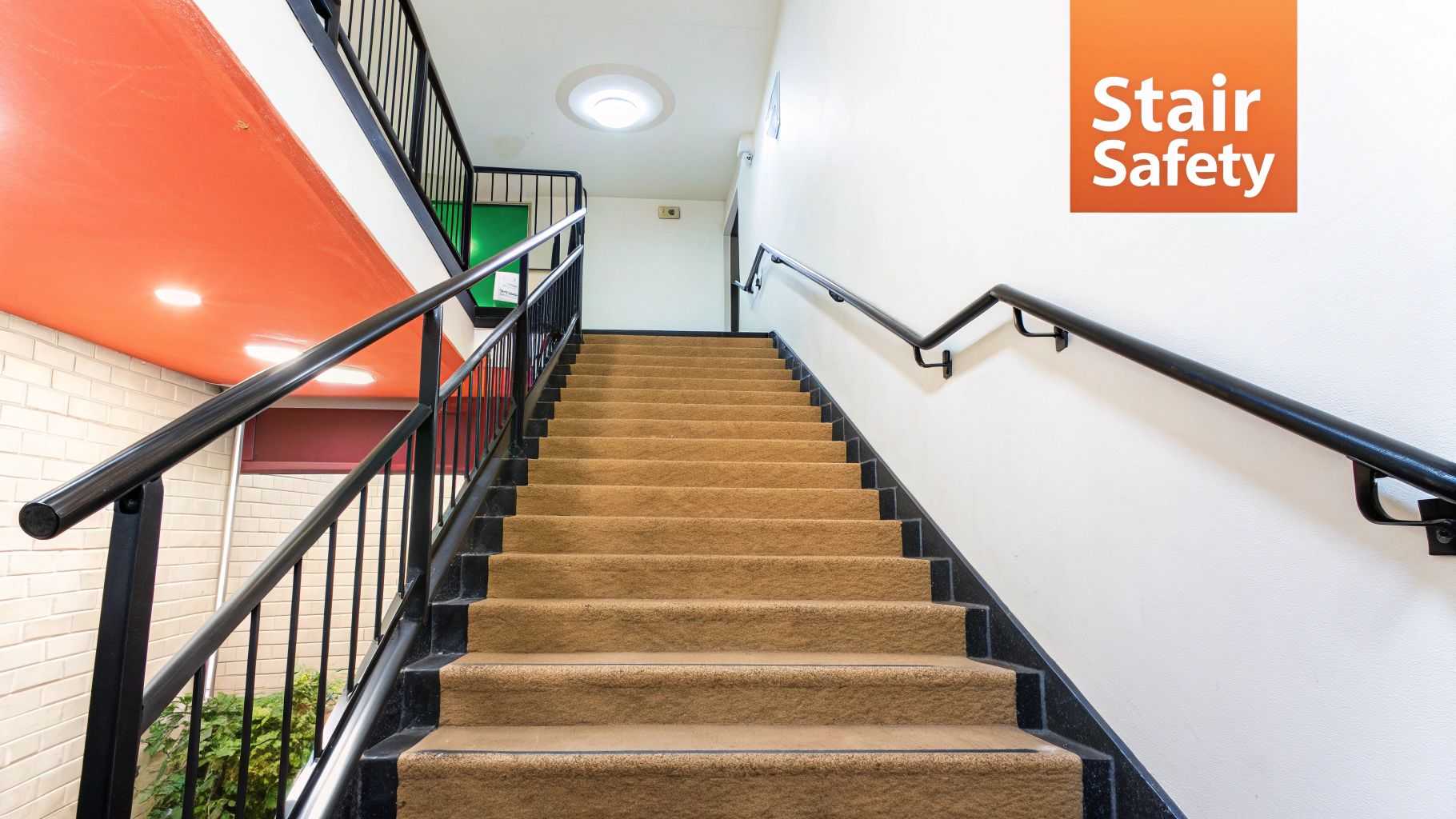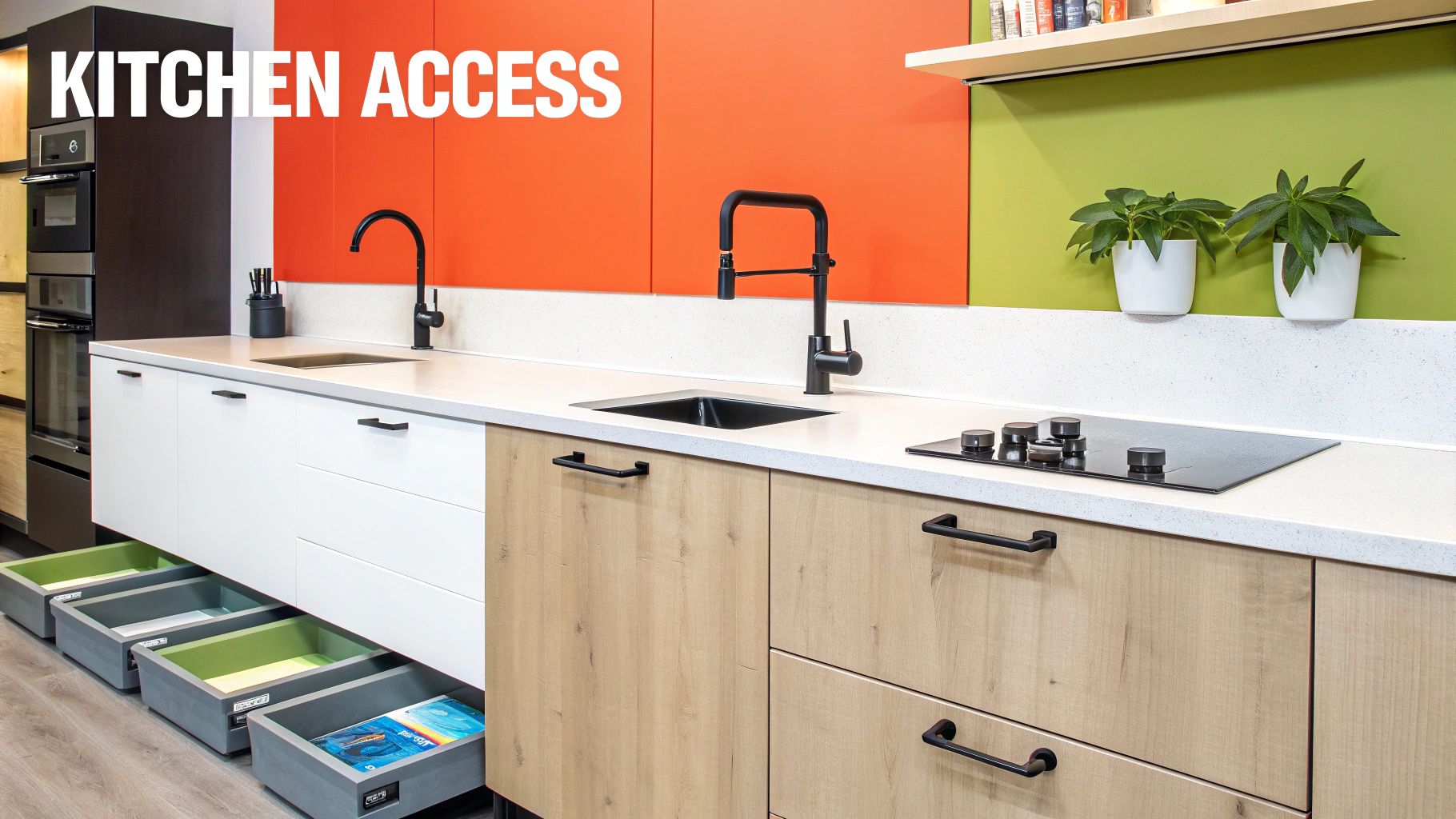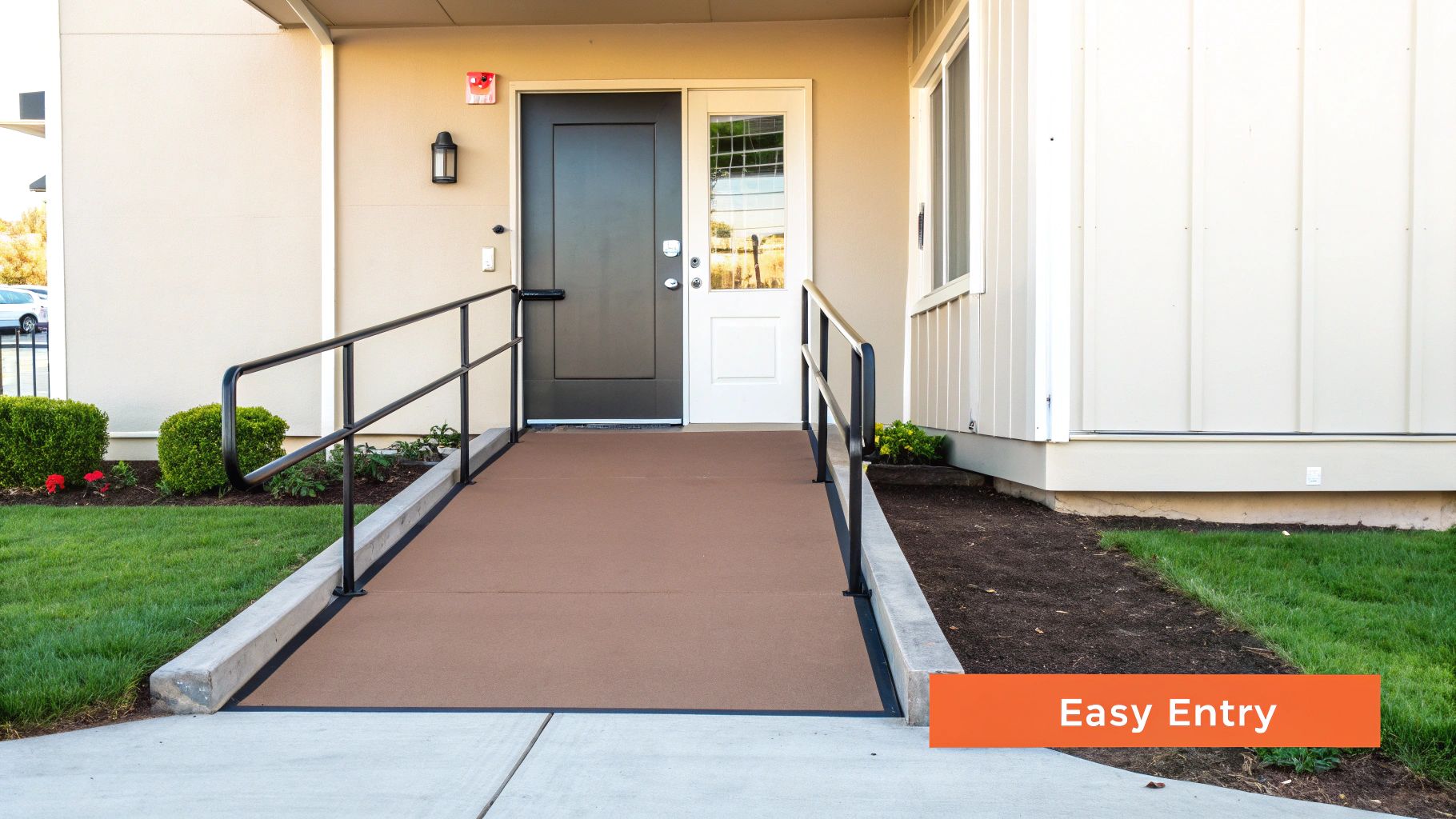-
CALL US:
- (866) 952-3456
The desire for most seniors is to remain in the comfort and familiarity of their own homes, a concept widely known as ‘aging in place.’ This goal, however, hinges on a critical factor: the safety and accessibility of the living environment. As mobility, vision, and strength naturally change over time, a home that was once a perfect fit can present new and unexpected challenges, turning simple hallways or bathrooms into potential hazards.
Proactively implementing strategic home modifications for elderly residents is far more than just a preventive measure against accidents. It is a powerful investment in preserving independence, dignity, and overall quality of life. Making these essential changes before they become urgent needs ensures a smoother, less stressful transition while actively supporting long-term well-being and confidence.
This comprehensive guide moves beyond generic advice to provide a detailed roundup of the most impactful modification areas. We will explore practical, actionable solutions for every part of the house, including:
For each category, you will find specific cost considerations, installation tips, and expert insights to transform any house into a secure, comfortable, and empowering forever home.
The bathroom is statistically one of the most hazardous rooms for seniors. A combination of water, hard surfaces, and the need to bend and balance creates a high risk for falls, which can lead to serious injury. Comprehensive bathroom safety updates are among the most crucial home modifications for elderly individuals aiming to age in place safely and maintain their independence. These modifications focus on improving stability, accessibility, and overall visibility to mitigate common dangers.

Key modifications transform this high-risk space into a secure environment. Walk-in showers or walk-in tubs, like those popularized by brands such as Kohler and Safe Step, eliminate the high threshold of a conventional bathtub, which is a significant tripping hazard. Inside the shower, a built-in or portable shower seat provides a secure place to rest, reducing fatigue and the risk of slipping while bathing. Strategically placed grab bars offer stable handholds for navigating the tub, shower, and toilet area.
These modifications are not just about convenience; they are about proactive injury prevention. According to Home Depot's bathroom modification services, professionally installed safety features have been linked to a 40% reduction in customer falls. The Department of Veterans Affairs also prioritizes these updates in its Specially Adapted Housing (SAH) grant program, recognizing their profound impact on veteran safety and quality of life. Making these changes can dramatically decrease the likelihood of a fall, providing critical peace of mind for both seniors and their families.
For many seniors, stairs represent a significant daily obstacle and one of the highest-risk areas for falls in the home. With over a million stair-related injuries reported annually in the U.S., addressing this hazard is a top priority for aging in place. Stair safety and accessibility solutions are home modifications for elderly residents designed to transform multi-level homes from a source of danger into a safely navigable space, promoting continued mobility and access to all parts of the house.

The most comprehensive solution is a stair lift, a motorized chair that travels along a rail fitted to the staircase. Industry leaders like Bruno Independent Living Aids and Stannah Stairlifts offer a range of models for straight, curved, and even outdoor staircases. For more complex needs, Acorn Stairlifts specializes in custom curved rail systems, while companies like Harmar Mobility provide platform lifts that can accommodate a wheelchair, ensuring full accessibility for all mobility levels.
These modifications are about more than just convenience; they are a direct line of defense against life-altering falls. Eliminating the need to navigate stairs under one's own power drastically reduces the risk of injury and preserves energy. For seniors who might otherwise be confined to a single floor, a stair lift restores full access to their home, preventing isolation and improving overall quality of life. Implementing these changes is part of a broader approach to home accessibility. Just as bathrooms must meet specific standards, such as ADA faucet requirements, stairways require their own dedicated safety protocols to ensure a truly safe living environment.
The kitchen is often the center of daily life, but for many seniors, it can present significant challenges. Tasks like reaching into high cabinets, bending down for pots and pans, or even turning a small knob can become difficult and increase the risk of a fall or strain. Essential home modifications for elderly individuals often center on the kitchen, aiming to create a safe, ergonomic, and accessible environment. These upgrades are designed to reduce physical effort, prevent accidents, and empower seniors to continue enjoying the independence of preparing their own meals.

Transforming the kitchen involves bringing key items and work areas within easy reach. Industry leaders like Rev-A-Shelf and KraftMaid have popularized solutions such as pull-down shelving for upper cabinets and full-extension, pull-out shelves for lower cabinets, which eliminate the need for deep bending. Installing varied-height countertops, a central feature in IKEA’s accessible kitchen designs, can comfortably accommodate a user who needs to be seated. Furthermore, upgrading to lever-style faucet handles and installing soft-close drawer systems from innovators like Blum can dramatically reduce the force and dexterity required for everyday kitchen tasks.
An accessible kitchen is directly linked to a senior’s health and overall well-being. When cooking becomes too arduous or unsafe, it can lead to a reliance on less-healthy convenience foods or a general decline in nutritional intake. By removing physical barriers, these modifications enable seniors to maintain a balanced diet and preserve the daily routines that bring them comfort and purpose. This philosophy is championed by organizations like the Universal Design Living Laboratory, which demonstrates how thoughtful design fosters long-term independence and boosts confidence at home.
As vision naturally declines with age, what was once adequate lighting can become dangerously dim. Upgrading a home's lighting and electrical systems is one of the most impactful home modifications for elderly individuals. Seniors often need two to three times more ambient light than younger adults to see clearly, making well-planned illumination essential for navigating safely, avoiding trip hazards, and performing daily tasks like reading medication labels or cooking. These improvements focus on increasing brightness, eliminating shadows, and making controls more accessible.

Modern technology offers a range of solutions to fit any home. Smart lighting systems, such as those from Philips Hue, allow for voice or remote control, eliminating the need to fumble for a switch in the dark. Brands like Lutron offer motion-sensing switches that automatically illuminate a room upon entry, perfect for hallways and bathrooms. For targeted lighting in dark closets or under cabinets, wireless, battery-powered LED puck lights from GE or motion-activated lights from Mr. Beams provide a simple yet effective upgrade without complex wiring.
Proper lighting is a fundamental component of fall prevention. Dimly lit stairs, hallways, and living areas create hidden hazards by obscuring obstacles like rugs, furniture, or pets. The transition between a bright room and a dark one can also cause temporary disorientation, increasing the risk of a stumble. By ensuring consistent and bright illumination, these modifications directly address a primary cause of accidents, allowing seniors to move about their homes with greater confidence and security, day or night.
Proper installation is key for safety and function. If you need help with new fixtures, consider a professional lamp assembly service to ensure it's done right.
The ground beneath our feet is often overlooked, yet it poses one of the greatest risks for falls. Uneven surfaces, high-pile carpets that snag walkers, slippery tiles, and abrupt transitions between rooms can easily lead to a loss of balance. Upgrading floors is therefore one of the most impactful home modifications for elderly individuals, creating a stable and predictable foundation for safe movement throughout the house. This modification prioritizes slip resistance and the elimination of tripping hazards.
Modern flooring solutions combine safety with style, making it easy to create an accessible environment. Brands like Shaw Floors and Mohawk Industries offer luxury vinyl plank (LVP) and slip-resistant tile collections that provide excellent traction without a clinical look. Replacing worn, thick carpeting with low-pile carpet or a hard surface like cork or LVP removes a common tripping hazard. Companies like Armstrong and Tarkett also provide healthcare-grade safety flooring, designed with maximum grip and durability, which can be seamlessly installed in residential settings to eliminate thresholds between rooms.
The stakes are incredibly high when it comes to flooring. Falls related to environmental hazards, including unsafe floors, contribute to over 32,000 deaths annually among adults over 65. By investing in safer flooring, you are directly addressing a leading cause of fatal and non-fatal injuries. This proactive step provides a secure foundation for daily activities, enhancing mobility and giving seniors the confidence to navigate their homes independently.
Navigating doorways and entrances can become a significant challenge for seniors, especially those who use walkers or wheelchairs. Standard doorways, often only 24 to 30 inches wide, can be impassable barriers, while traditional doorknobs can be difficult for arthritic hands to operate. Upgrading these access points is a fundamental component of home modifications for elderly individuals, ensuring they can move freely and safely throughout their entire home.
Key changes involve widening main doorways to at least 36 inches to accommodate mobility aids and replacing round knobs with lever-style handles that don't require tight gripping. For exterior steps, modular ramp systems from brands like EZ-ACCESS provide a safe, gradual incline. Technology also plays a role; Stanley Access Technologies offers automatic door operators for residential use, and security systems like Ring video doorbells or Schlage's keyless entry with large buttons enhance safety and convenience.
Accessible entryways are critical for maintaining autonomy and preventing social isolation. When a senior can't easily get in and out of their house or move from room to room, their world shrinks. These modifications empower them to navigate their environment without assistance, reducing the risk of getting stuck or injured while trying to squeeze through tight spaces. It's a proactive step that supports the long-term use of mobility aids and fosters a sense of confidence and independence.
Integrating smart home technology is an increasingly popular and effective way to enhance safety and support independent living for older adults. These systems use connected devices to automate tasks, monitor for emergencies, and simplify daily routines. Far from being a luxury, this is one of the most impactful home modifications for elderly individuals, offering a digital safety net that provides significant peace of mind for both seniors and their families by bridging the gap between independence and caregiver oversight.
The applications range from simple convenience to life-saving alerts. Voice-activated assistants, such as Amazon Alexa with its Senior Planet partnership, can set medication reminders, control lights, and make hands-free calls. Dedicated personal emergency response systems, pioneered by companies like Life Alert, provide immediate access to help with the push of a button. Meanwhile, devices like the Philips GoSafe offer mobile GPS tracking for safety outside the home, and platforms like GrandPad provide simplified tablets designed specifically for seniors to easily connect with loved ones.
This technology provides a proactive layer of support that traditional modifications cannot. It enables remote monitoring and instant communication, which is crucial for seniors who live alone. According to a recent AARP survey, over 75% of adults over 50 want to age in place, and smart technology is a key enabler. These systems can automatically detect falls, monitor activity patterns for potential health issues, and provide immediate emergency contact. This constant, non-intrusive support system empowers seniors to live confidently and independently for longer.
| Item | Implementation Complexity 🔄 | Resource Requirements ⚡ | Expected Outcomes 📊 | Ideal Use Cases 💡 | Key Advantages ⭐ |
|---|---|---|---|---|---|
| Bathroom Safety Modifications | Moderate to High (plumbing, professional help) | Medium to High (materials, installation) | High fall risk reduction, improved accessibility | High-risk wet areas, elderly bathrooms | Maintains independence, gradual upgrades, universal design appeal |
| Stair Safety and Accessibility Solutions | Moderate (equipment installation, possible custom rail) | Medium to High (stair lifts costly, maintenance) | Significantly reduced stair fall risk, multi-level home usability | Multi-story homes with mobility challenges | Enables stair use, removable solutions, battery backup |
| Kitchen Accessibility Upgrades | High (remodels, permits, construction) | High (full kitchen remodel possible) | Maintains independence in meal prep, safety improvement | Kitchens with mobility or reach limitations | Reduces strain, accommodates wheelchairs, increases home value |
| Lighting and Electrical Improvements | Low to Moderate (mostly straightforward wiring) | Low to Medium (LED upgrades, sensors) | Improves safety, reduces eye strain, better visibility | All home areas needing better illumination | Energy-efficient, quick install, hands-free control |
| Flooring Modifications for Safety | Moderate (floor replacement, threshold work) | Medium (materials, labor) | Reduced slip/fall risk, better mobility aid use | Entire home, especially high-traffic and wet zones | Safer surfaces, easier navigation, allergy friendly |
| Door and Entryway Accessibility | Moderate to High (structural, hardware changes) | Medium to High (widening, ramps, tech) | Improved mobility access, security enhancements | Entrances, bathrooms, high traffic doorways | Wheelchair compatibility, enhanced security, step elimination |
| Smart Home Technology Integration | Low to Moderate (device setup, connectivity) | Low to Medium (devices, subscriptions) | Increased safety monitoring, task automation, emergency response | Independent living seniors needing monitoring and assistance | Voice control, remote monitoring, easy installation |
Transforming a living space to support aging in place is one of the most impactful investments you can make in long-term well-being and independence. As we've detailed, a truly effective strategy involves more than just a few scattered updates. It requires a holistic view, addressing everything from the fundamental safety of bathrooms and stairways to the enhanced convenience of an accessible kitchen and the modern support of smart home technology. The journey to a safer home is deeply personal, and the most successful outcomes begin not with a purchase, but with a plan. By thoughtfully implementing these home modifications for elderly individuals, you are building a powerful foundation for a secure and autonomous future.
The first and most critical step is a comprehensive home assessment. Walk through every room with the person who will be living there, taking careful notes on their daily routines, frustrations, and areas of concern. What feels difficult? Where do they feel unsteady? This collaborative audit will provide a clear, personalized blueprint that prioritizes genuine needs over generic solutions.
Once you have your list, organize it based on impact and urgency. A tiered approach can make the process feel manageable and ensure the most critical risks are addressed first.
Remember, this process can be phased over time to align with your budget and schedule. Start with low-cost, high-impact changes before committing to more significant renovations. Many crucial improvements, like adding nightlights or applying non-slip strips to stairs, are both affordable and simple to implement.
As you consider tech-based solutions like automatic lighting, voice-activated assistants, or remote monitoring systems, the reliability of your home network becomes paramount. These life-enhancing devices are only effective if they have a consistent connection. For a truly robust and dependable network capable of supporting these critical functions, it’s wise to explore professional-grade Wi-Fi solutions designed to eliminate dead zones and ensure seamless performance when it matters most.
Ultimately, these home modifications for elderly loved ones are about much more than physical safety. They are a tangible expression of care that fosters dignity, reduces anxiety, and preserves a cherished sense of autonomy. Every adjustment, no matter how small, contributes to an environment that is not just safe, but also supportive, comfortable, and empowering for years to come.
Many of these modifications, from entryway benches that make putting on shoes easier to accessible shelving units and more suitable bed frames, require assembly. For professional, secure, and stress-free setup of your new furniture, trust the experts at Assembly Smart to ensure every piece is built correctly and safely.